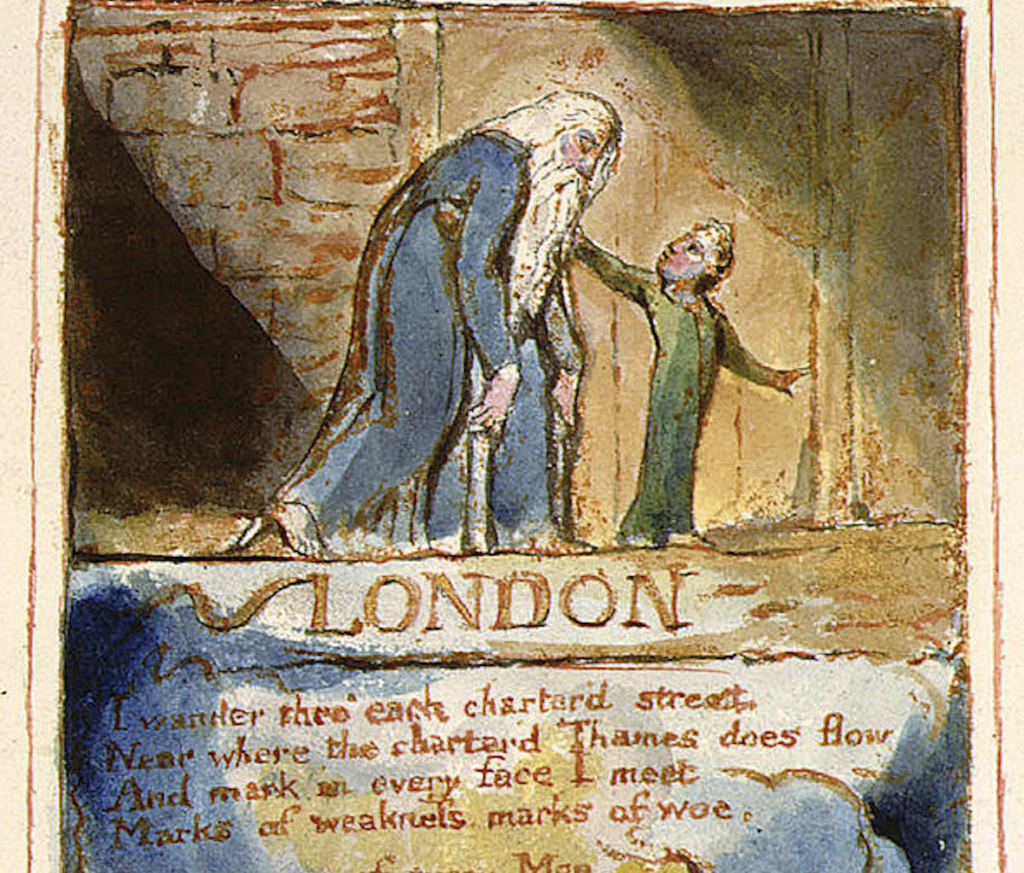William Blake may be best known for Last Night of the Proms favourite “Jerusalem”, but he’s also enduringly associated with London – his celebrated poem of that name is still resonant in today’s city of wealth and poverty.
“I wander thro’ each charter’d street,
Near where the charter’d Thames does flow,
And mark in every face I meet
Marks of weakness, marks of woe.”
Born in Soho in 1757, Blake lived in the capital almost his whole life, never far from his childhood home in Broad (now Broadwick) Street, where his family ran a hosiery and haberdashery business.
Beginning his married life in Green Street by Leicester Square, he subsequently lived in Poland Street, in Hercules Buildings in Lambeth, in South Molton Street and, finally, in Fountain Court, off the Strand, with a view of the Thames.
A brief stay in rural Sussex doesn’t seem to have been a success; wrongfully arrested for sedition following an argument with a soldier, he returned rapidly to the city.
Tate Britain’s current major exhibition, the largest for 20 years, seeks to place Blake firmly in this urban context, presenting more than 300 works in chronological order, from his early drawing school days and his time studying at the Royal Academy (then based in Somerset House) to his working life as professional engraver, printmaker, poet and painter.
It’s a comprehensive survey of an artist who, as the exhibition guide says, has “influenced generations”, with a focus not on explanation of Blake’s symbolism and mythology but on the “personal and social conditions in which it was made”.
Blake struggled for acceptance, self-publishing while working effectively as a jobbing graphic artist, relying on patrons with a taste for the obscure, and artist colleagues with a generous understanding of his inspiration.
Contemporary critics were generally less sympathetic. The exhibition includes a striking partial reconstruction of a show Blake staged in 1809 in an upstairs room above the family shop in Soho, an act of “high ambition and disastrous failure” . It garnered one review, describing him as an “unfortunate lunatic”.
His inspiration was literally visionary. As a boy walking in Peckham Rye he saw a tree filled with angels and he continued to have inspirational visitations from historical and mythological figures throughout his life .
“I write when commanded by the spirits,” he said, and, in conversation with diarist Crabb Robinson: “I have conversed with the spiritual Sun. I saw him on Primrose Hill” – a quote now inscribed in York stone at the hill’s highest point.
For Blake then, London was more than the “specific circumstances” of “his own time”, in which the exhibition seeks to root his work – though its focus does serve to highlight the extraordinary qualities of his output, more complex and more cryptic than attempts to place him as a radical product of his revolutionary era suggest.
Blake’s London, as this accumulation of prints, watercolours and oils underlines, is a city of the mind. “My streets are my ideas of imagination,” he wrote. Unsurprisingly he has been heralded as “urban shaman and psychogeographer”, and celebrated by contemporary proponents including Iain Sinclair.
Was it this metropolis of possibility that enabled his creativity, as it has for artists before and since? In London, he wrote, he alone could carry on his “visionary studies…see Visions, dream Dreams…and speak Parables unobserv’d”.
The power of the exhibition, then, is perhaps not its chronicling of the specific urban context of Blake’s work, but its sense of the city making an extraordinary vision possible. Not to be missed.
The exhibition runs at Tate Britain until February 2, accompanied on the Tate website by a picture essay on Blake’s London.
OnLondon.co.uk is dedicated to providing fair, thorough, anti-populist coverage of London’s politics, development and culture. It depends on donations from readers and would like to pay its freelance contributors better. Can you spare £5 (or more) a month? Follow this link to donate. Thank you.

